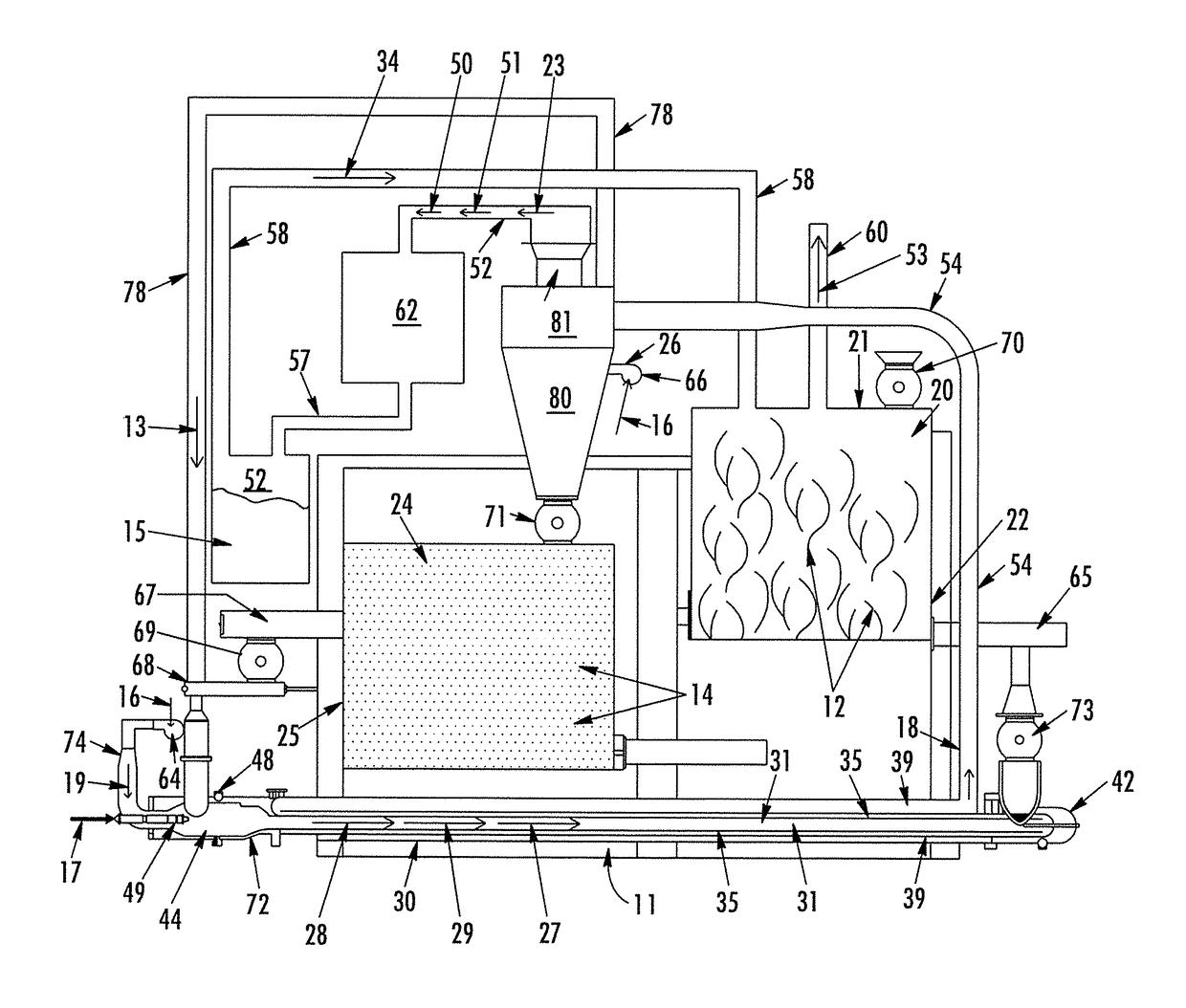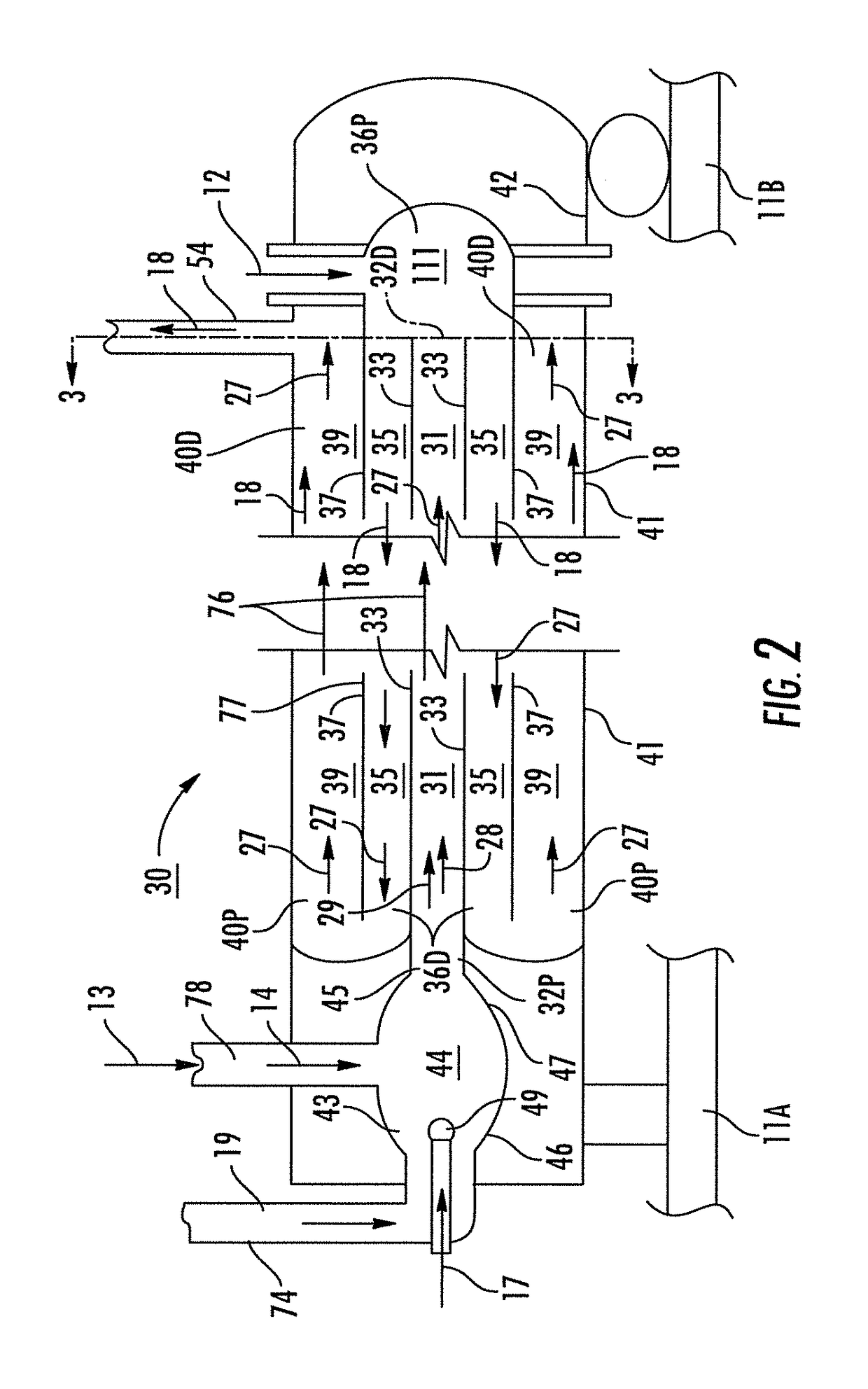Systems, apparatus and methods for optimizing the rapid pyrolysis of biomass
a biomass and pyrolysis technology, applied in the direction of charging devices, oven incrustation prevention/removal, products, etc., can solve the problems of nuclear power raising the specter of ecological damage, emission of excessive amounts of carbon dioxide into the atmosphere, and substantial environmental problems in the united states, so as to prolong the shelf life, increase the viscosity of the pyrolysis oil, and increase the effect of the viscosity
- Summary
- Abstract
- Description
- Claims
- Application Information
AI Technical Summary
Benefits of technology
Problems solved by technology
Method used
Image
Examples
first embodiment
[0052]a fast pyrolysis system in accordance with this invention is depicted in FIGS. 1-4 and designated generally by reference numeral 10.
[0053]Referring now to FIG. 1, the system 10 comprises a biomass feed bin 20 for receiving and delivering biomass 12 into a pyrolysis unit 30, described in detail below. The biomass feed bin 20 is enclosed to provide greater control over the channeling of exhaust 34 (shown as an arrow) from pyrolytic reactions that is fed into the feed bin 20. The biomass 12 is fed through a top 21 of the feed bin 20 using rotary air lock 70. The biomass 12 is delivered into the pyrolysis unit 30 from the feed bin 20 by an auger 65 attached to a lower portion 22 of the biomass feed bin 20. In this way, the biomass feed bin 20 continually feeds new biomass 12 through the system 10 into the unit 30.
[0054]With continued reference to FIG. 1, the biomass feed bin 20 accepts raw biomass 12. The present embodiment envisions receiving this biomass 12 primarily from sawmil...
embodiment 200
[0086]FIGS. 9 and 10 describe a preferred embodiment of the energy-conversion system 200 shown in FIG. 7. Referring first to FIG. 9, raw biomass 204 is ground into cubes at step 220. The ground biomass 204 is then subjected to drying 230. Optimally, the dried biomass 204 has a moisture content of no more than twelve percent. In other embodiments, steam resulting from the drying process 230 is collected for re-use by other parts of the system 200. Hot exhaust gas 320 from the fast pyrolysis system 206 is used in generating electricity 300 which, in turn, is used to aid in the drying process 230. The exhaust gas 320 has a typical temperature of approximately five-hundred degrees Fahrenheit or greater and has a typical oxygen content of approximately fifteen percent. A portion of the exhaust 320 is also used to aid in the rapid pyrolysizing of the biomass 250. Before the exhaust 320 can be used for fast pyrolysis 250, however, it must be deoxygenated. To rid the exhaust 320 of its oxyg...
embodiment 500
[0088]FIGS. 11 and 12 illustrate flow diagrams of another preferred embodiment of an energy-conversion system 500 in accordance with this invention. Referring first to FIG. 11, raw biomass 204 is ground into cubes of between about one-quarter and one-eighth inch. The ground biomass 12 is then subjected to drying 230. Steam from the drying process 230 is collected at step 236 for re-use by other parts of the system or vented to the atmosphere. The biomass 204 is now ground into a powder at step 510, in order to promote a faster reaction time when subjected to fast pyrolysis. In the present embodiment 500, the particle size and shape are optimized for the production of bio-oil plus at step 575. In other embodiments, the process to grind the biomass to a smaller size at 510 will be optimized for the production of bio-oil or other products. The dry powdered biomass 204 is compressed and transported at step 550 to a chamber where it is to be rapidly pyrolysized at step 250. The distance ...
PUM
| Property | Measurement | Unit |
|---|---|---|
| temperatures | aaaaa | aaaaa |
| length | aaaaa | aaaaa |
| length | aaaaa | aaaaa |
Abstract
Description
Claims
Application Information
 Login to View More
Login to View More - R&D
- Intellectual Property
- Life Sciences
- Materials
- Tech Scout
- Unparalleled Data Quality
- Higher Quality Content
- 60% Fewer Hallucinations
Browse by: Latest US Patents, China's latest patents, Technical Efficacy Thesaurus, Application Domain, Technology Topic, Popular Technical Reports.
© 2025 PatSnap. All rights reserved.Legal|Privacy policy|Modern Slavery Act Transparency Statement|Sitemap|About US| Contact US: help@patsnap.com



